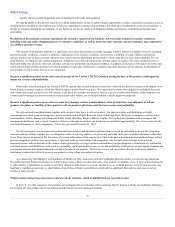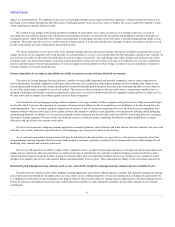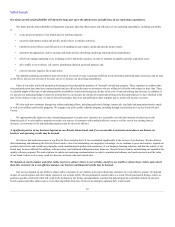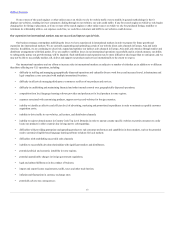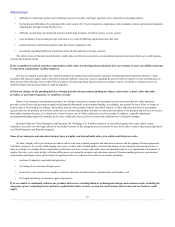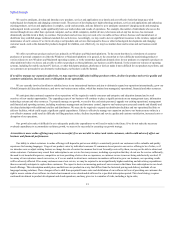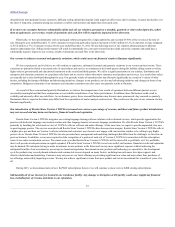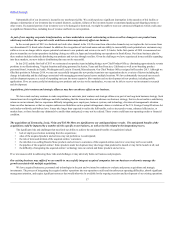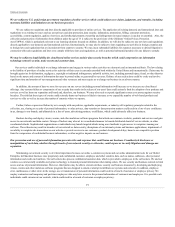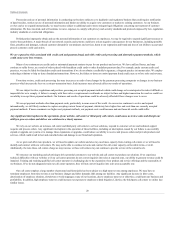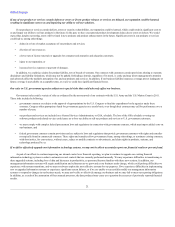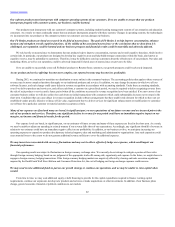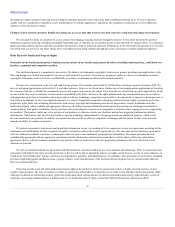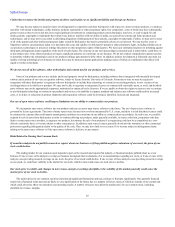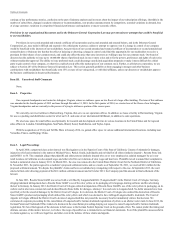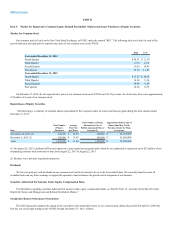Rosetta Stone 2013 Annual Report Download - page 21
Download and view the complete annual report
Please find page 21 of the 2013 Rosetta Stone annual report below. You can navigate through the pages in the report by either clicking on the pages listed below, or by using the keyword search tool below to find specific information within the annual report.
Table of Contents
Possession and use of personal information in conducting our business subjects us to legislative and regulatory burdens that could require notification
of data breaches, restrict our use of personal information and hinder our ability to acquire new customers or market to existing customers. As our business
evolves and as we expand internationally, we may become subject to additional and/or more stringent legal obligations concerning our treatment of customer
information. We have incurred, and will continue to incur, expenses to comply with privacy and security standards and protocols imposed by law, regulation,
industry standards or contractual obligations.
If third parties improperly obtain and use the personal information of our customers or employees, we may be required to expend significant resources to
resolve these problems. A major breach of our network security and systems could have serious negative consequences for our businesses, including possible
fines, penalties and damages, reduced customer demand for our products and services, harm to our reputation and brand and loss of our ability to accept and
process customer credit card orders.
We are exposed to risks associated with credit card and payment fraud, and with credit card processing and alternative payment methods, which
could cause us to lose revenue.
Many of our customers use credit cards or automated payment systems to pay for our products and services. We have suffered losses, and may
continue to suffer losses, as a result of orders placed with fraudulent credit cards or other fraudulent payment data. For example, under current credit card
practices, we may be liable for fraudulent credit card transactions if we do not obtain a cardholder's signature, a frequent practice in internet sales. We employ
technology solutions to help us detect fraudulent transactions. However, the failure to detect or control payment fraud could cause us to lose sales and revenue.
From time to time, credit card processing fees may increase as a result of rate changes by the payment processing companies or changes in our business
practices which increase the fees on a cost-per-transaction basis. Such increases may adversely affect our results of operations.
We are subject to rules, regulations and practices governing our accepted payment methods which could change or be reinterpreted to make it difficult or
impossible for us to comply. A failure to comply with these rules or requirements could make us subject to fines and higher transaction fees and we could lose
our ability to accept these payment methods. Our business and results of operations could be adversely affected if these changes were to occur.
We accept payment methods other than payment cards, particularly in some areas of the world. As our service continues to evolve and expand
internationally, we will likely continue to explore accepting various forms of payment, which may have higher fees and costs than our currently accepted
payment methods. If more consumers use higher cost payment methods, our payment costs could increase and our financial results could suffer.
Any significant interruptions in the operations of our website, call center or third-party call centers could cause us to lose sales and disrupt our
ability to process orders and deliver our solutions in a timely manner.
We rely on our website, an in-house call center and third-party call centers to sell our solutions, respond to customer service and technical support
requests and process orders. Any significant interruption in the operation of these facilities, including an interruption caused by our failure to successfully
expand or upgrade our systems or to manage these expansions or upgrades, could reduce our ability to receive and process orders and provide products and
services, which could result in lost and cancelled sales and damage to our brand and reputation.
As we grow and offer more products, we will need to update our website and also may need more capacity from existing call centers or we will need to
identify and contract with new call centers. We may not be able to continue to locate and contract for call center capacity on favorable terms, or at all.
Additionally, the rates those call centers charge us may increase or those call centers may not continue to provide service at the current levels.
We structure our marketing and advertising to drive potential customers to our website and call centers to purchase our solutions. If we experience
technical difficulties with our websites or if our call center operators do not convert inquiries into sales at expected rates, our ability to generate revenue could be
impaired. Training and retaining qualified call center operators is challenging due to the expansion of our product and service offerings and the seasonality of
our business. If we do not adequately train our call center operators, they will not convert inquiries into sales at an acceptable rate.
Our call center employs a large number of personnel and historically has been subject to a high turnover rate among employees. We may have to
terminate employees from time to time as our business changes and labor demands shift among our facilities. Any significant increase in labor costs,
deterioration of employee relations, slowdowns or work stoppages at any of our locations, due to employee turnover or otherwise, could harm our business and
profitability. In addition, high employee turnover could increase our exposure to employee-related litigation. Likewise, the third-party call centers we utilize face
similar issues.
20


